Vancouver, British Columbia–(Newsfile Corp. – February 18, 2021) – Blue Star Gold Corp. (TSXV: BAU) (FSE: 5WP) (“Blue Star” or the “Company”) announces a significant increase in its land holdings in the highly prospective and underexplored High Lake Greenstone Belt (“HLGB”), Nunavut following an agreement to acquire a 100% interest in the Roma Project claims. Blue Star will be the largest title holder in the HLGB following the acquisition of the Roma Project claims, effectively creating a district scale project in the region when combined with the Company’s Ulu and Hood River Projects in the south section of the belt. Blue Star now controls 16,645 hectares in this very prospective and underexplored district.
Highlights:
- Acquisition of 100% interest in 7,683 hectares of highly prospective mineral claims (Roma Project) in HLGB gives Blue Star access to 44 km of the belt
- Multiple significant gold showings are present on the Roma Project within a 6.5 km by 2.4 km area, including several drill ready targets
- Numerous high-grade gold showings and zones were discovered in the 1990’s with little to no follow-up work conducted since that time
- Grab samples up to 126 g/t Au and chip samples up to 24 g/t Au over 1.5 m
- Limited shallow drilling (10 holes for 465 m) returned 12.38 g/t Au over 2.31 m and 8.69 g/t Au over 1.87 m
- The geologic setting and style of gold mineralization at the Roma Project is similar to that found at the Company’s Ulu Project, where a significant high grade gold resource has been outlined at the Flood Zone deposit
Blue Star’s CEO, Grant Ewing, commented: “Blue Star now controls a district scale project in an underexplored and highly prospective greenstone belt following the acquisition of a 100% interest in the Roma Project. The extent of the high-grade gold showings and the presence of multiple styles of gold mineralization, including those similar to our Flood Zone deposit at Ulu, present the Company with multiple opportunities for new discovery and resource growth.”
The Company’s flagship Ulu Project (Flood Zone deposit) and Hood River Property are situated in the south- central portion of the HLGB. Agnico Eagle holds a prospecting permit in the central section, and the Roma Project lies directly north and covers an extensive area of very prospective mineral claims (see Figs. 1.a and 1.b).
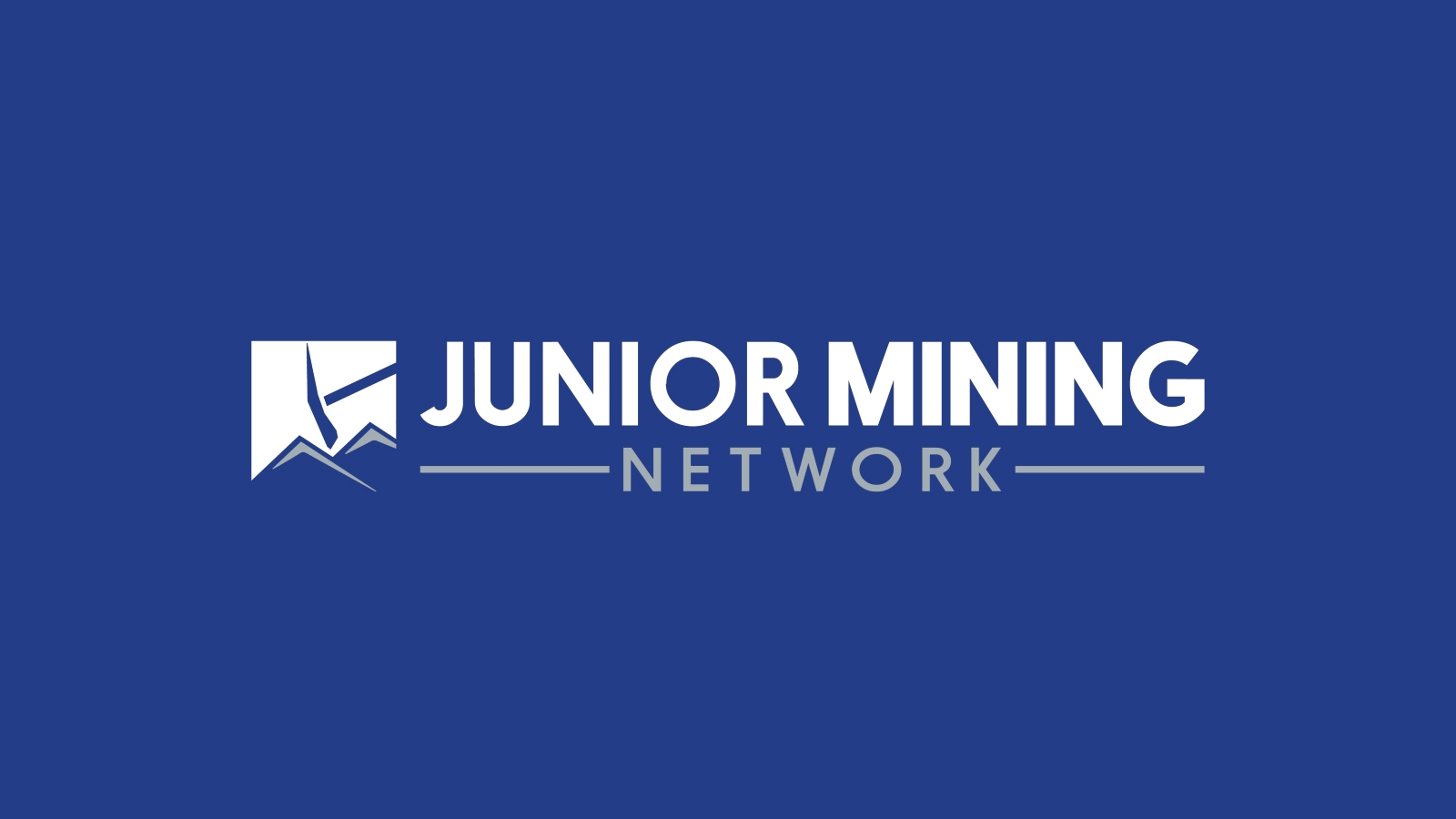
Figure 1a
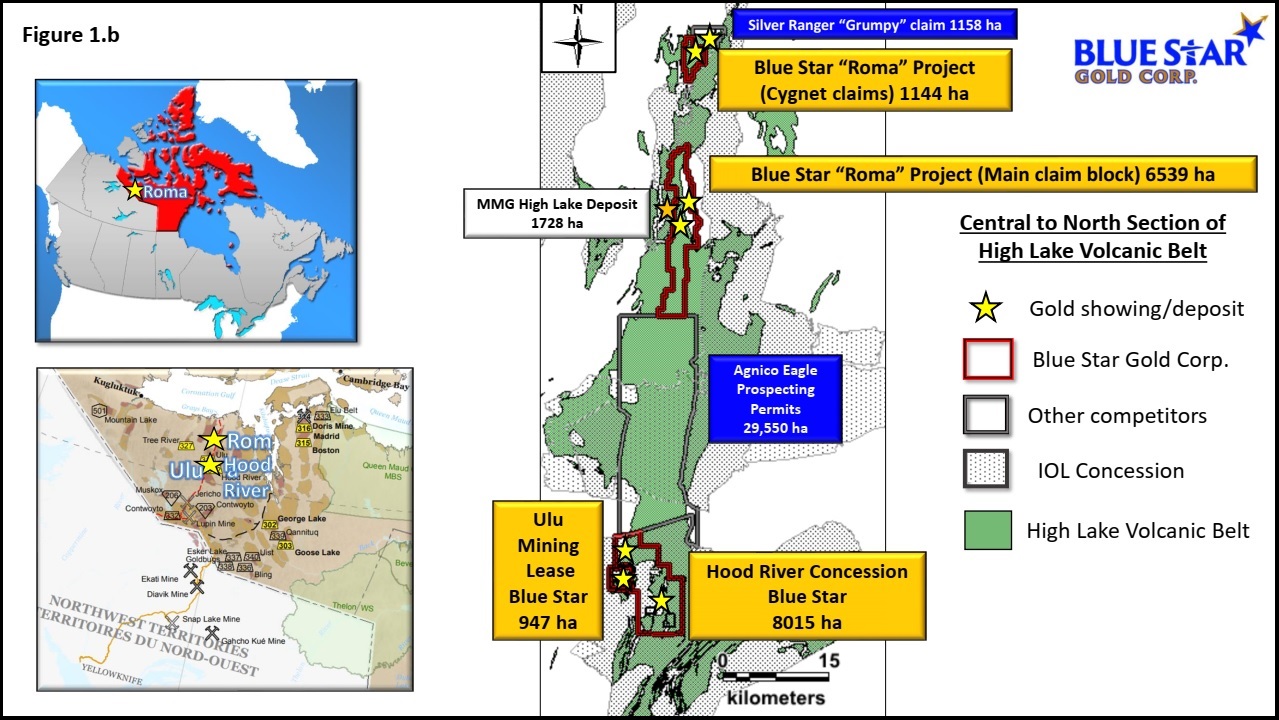
Figure 1b
Blue Star continues to conduct detailed planning for its upcoming 2021 exploration program. The primary exploration focus will be on expanding resources at the known deposit (Flood Zone) and testing high priority proximal targets on the Ulu Property. The early results from the extensive GIS compilation and targeting work that is ongoing is yielding several high-quality near surface targets close to the Flood Zone. The secondary exploration focus will be regional targeting/testing over the extensive and highly prospective Hood River and Roma Projects, where numerous high-grade gold showings exist.
Roma Project:
Roma consists of nine (9) claim blocks totalling 7,683 ha (76.83 km2) in the northern section of the High Lake Greenstone Belt. These claims cover high grade gold showings discovered by previous explorers, notably BHP Minerals from 1989 to 1994 on their Roma and Cygnet claims (see Fig. 2).
Multiple significant gold showings are present within a 6.5 km x 2.4 km area on the historic Roma claim block (see Fig. 3). The original showing is a 0.30 to 3.0 m wide quartz vein with semi-massive arsenopyrite plus tourmaline, pyrite and chalcopyrite exposed in outcrop and boulders for 2.0 km as described in BHP Minerals’ 1992 Assessment Report AR083068. Alteration of the host granodiorite adjacent to the veins includes carbonate + sericite + clay + talc + tourmaline +/- fuchsite. The auriferous quartz vein is located on the eastern border of the belt at an intermediate volcanic-granodiorite contact. Grab samples of the vein returned 2 to 126 g/t Au including assays of 14.5, 29.6, and 58.2 g/t Au (see Table 1 for surface sampling highlights). The highest-grade chip sample of 26.4 g/t Au over 1.0 m was from the northern section where the auriferous quartz vein is exposed in outcrop for 300 m. A value of 24.7 g/t Au over 1.5 m was reported from a chip sample in the southern section (1995 BHP Minerals Assessment Report AR083544).
In 1991, BHP drilled 10 shallow holes totalling 465 metres to test 1.72 km strike of the vein (see Fig. 4). All drill holes intersected quartz veins from 15 m to 37 m vertically below surface. Visible gold was noted in three of the drillholes and the best results were 12.38 g/t Au over 2.31 m (including 64.0 g/t Au over 0.37 m) from DDH MD-01 and 8.69 g/t Au over 1.87 m from MD-03. BHP did not drill downdip of the high-grade intersection in DDH MD-01 and did not step out to the north from this intercept. No follow up drilling is known to have been completed on this property after BHP’s initial drill program. The north-south trending quartz vein is reported to narrow to the north and may remain open to the south where the highest-grade grab samples were taken. Shearing was mapped along this contact for an additional 1.75 km to the south. Blue Star’s Roma Project covers more than 12 km of this volcanic-granodiorite contact. Bedrock exposure ranges from 10 – 30% in the project area which presents an opportunity for more discoveries under cover.
Additional discoveries on Roma were made in 1993 approximately 4 km southwest of the original quartz vein in a structurally complex area with polyphase deformation. Twelve showings were found in a 1.6 km x 0.55 km area on the east limb of an anticlinal fold structure adjacent to the Kennarctic Shear Zone (KSZ). Gold values up to 5.6 g/t Au were reported from a 1.0 to 2.5 m wide, north trending, acicular arsenopyrite bearing quartz-ankerite vein which is traceable in iron carbonate altered and sheared gabbro for 350 m (1995 BHP Minerals Assessment Report 083544). A second zone of mineralization with gold grades to 1.1 g/t Au was found 650 m north and traced in narrow shear zones within gabbro for 600 m. Several additional showings are present between the zones mentioned above and the highest-grade sample assayed 5.52 g/t Au. All of these acicular arsenopyrite associated gold showings in the anticline remain undrilled. Other gold showings with gold grades up to 6.1 g/t Au are found between the anticline hosted mineralization and the original Roma vein.
The structural setting and mineralization style of the Roma southwestern showings are similar to the mineralization found at the Flood Zone that occurs on Blue Stars Ulu Project located 48 km due south. Lithologic units within the anticline at Roma include gabbro, intermediate tuff, and biotite schist. The west limb of the anticline appears to be truncated or offset by the KSZ. The KSZ is a regional north trending structure that can be traced for at least 40 km and may represent a sheared unconformity as it separates the older High Lake volcanic sequence from the younger Central Domain of the belt. The anticline-hosted gold mineralization on Roma is found within 1 km of the KSZ. Approximately 2.5 km north of the anticline, along the KSZ, similar style mineralisation has returned gold assays as high as 6.1 g/t Au. The High Lake VMS deposit is located approximately 1 km west of the KSZ. Several gold showings including Roma, Grumpy, and Cygnet are found within 1 km of the KSZ. Very little gold exploration has been conducted in the High Lake Belt north of the James River.
The historic Cygnet claim area is located approximately 24 km north of the original Roma showing on a bend in the KSZ and the High Lake Greenstone belt. A northeast trending 3 km long, and up to 10 m wide shear zone can be traced in intermediate to felsic volcanics on the west side of the Kennarctic River. Initial reconnaissance by BHP Minerals in 1989 is reported to have returned values of 13.6 to 25.4 g/t Au (BHP assessment report 083062) from a 3 km long shear. Gold is found within the quartz veined, silicified and sericitized cores (0.30 to 2.0 m wide) of the shear zones in association with arsenopyrite and pyrite. A quartz vein with arsenopyrite and tourmaline hosted in quartz diorite on the Grumpy claim returned high grade values (up to 20 g/t Au / 1.0 m as reported on Silver Ranger Resources website) from trenching along a strike of 105 m. The section of the shear called the Central Zone is covered by the Cygnet claims. Values between 1.87 to 5.42 g/t Au were returned from the Central Zone with the highest-grade sample containing acicular arsenopyrite. Sediment-hosted gold mineralization is also found at Cygnet including an 8.4 g/t Au sample just east of the Kennarctic River on the current Roma claims.
The proposed all-weather Grays Bay Road would bisect the Roma Project as it routes to MMG’s High Lake deposit and continues south to Blue Star’s Ulu Project. The Canadian National Trade Corridors Fund has committed CAD $21.5 million to facilitate the design, permitting and development of the Grays Bay Road and deep-water Port (GBRP) Project. The Grays Bay Road is planned to link the High Lake Zn-Cu and Ulu gold deposits by all weather road from the Arctic coast to the terminus of the Tibbett-Contwoyto winter road, which provides access to Yellowknife.
Blue Star will issue 750,000 common shares to purchase a 100% interest in the Roma Project subject to approval by the TSX Venture Exchange.
Qualified Person
Darren Lindsay, P. Geo. and Vice President Exploration for Blue Star, is a Qualified Person under National Instrument 43-101 (“NI 43-101”) and has reviewed and approved the technical information contained in this news release.
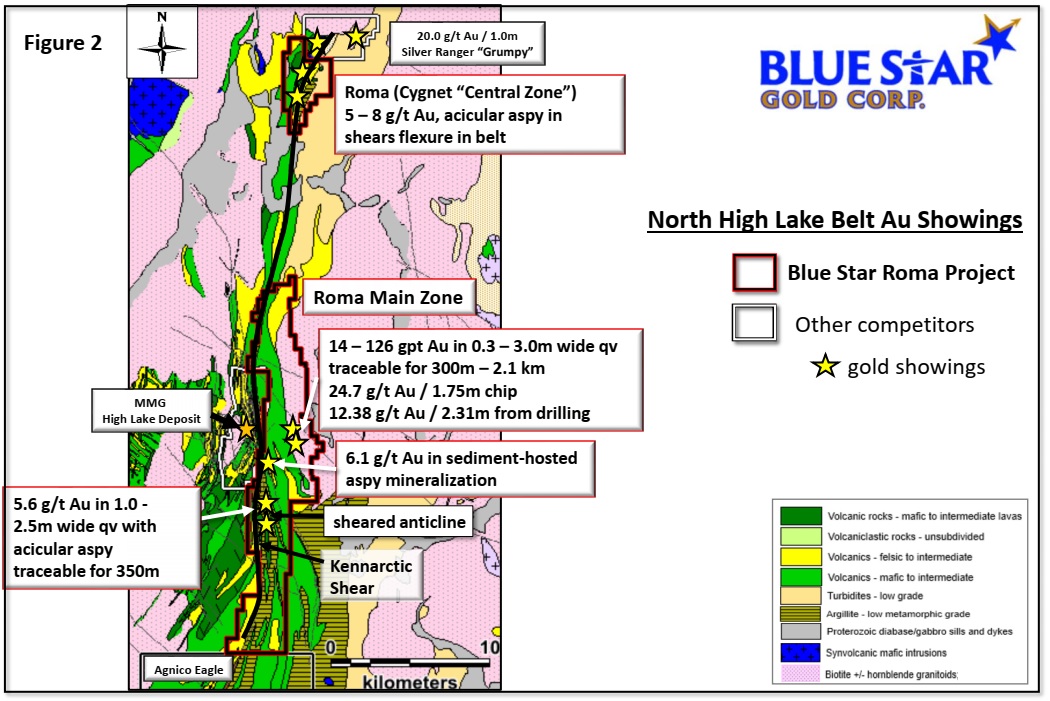
Figure 2
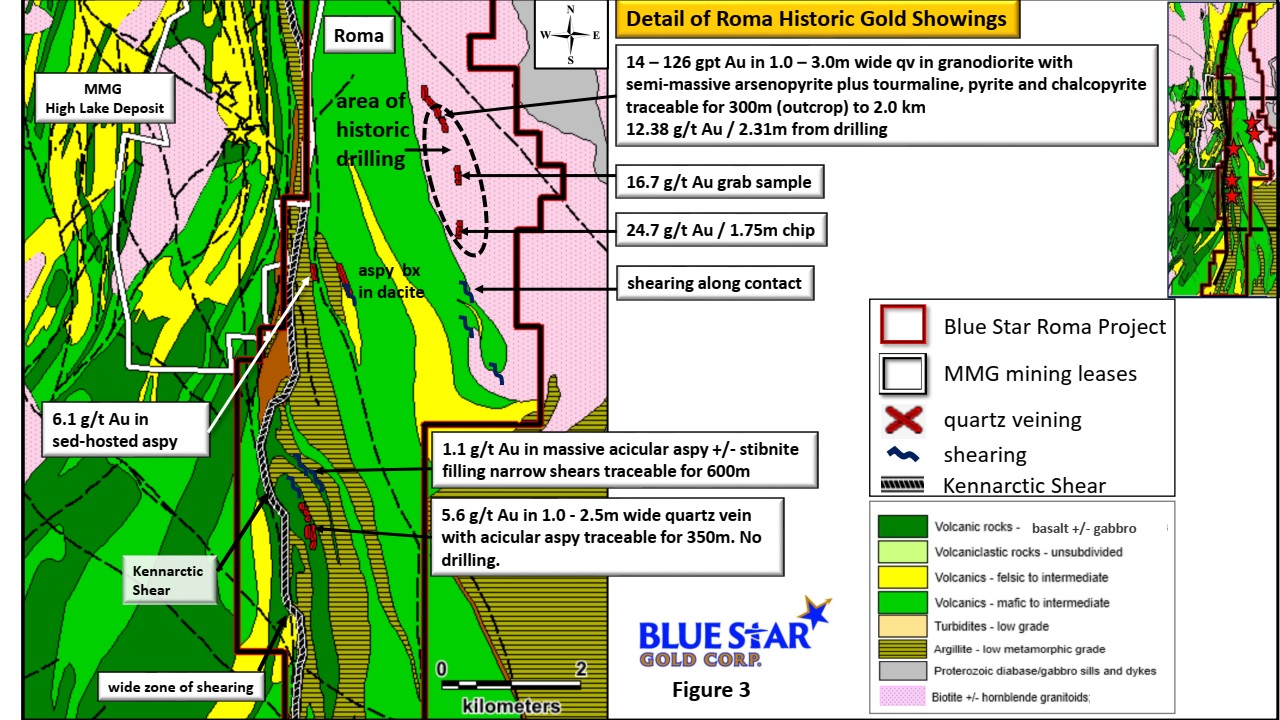
Figure 3
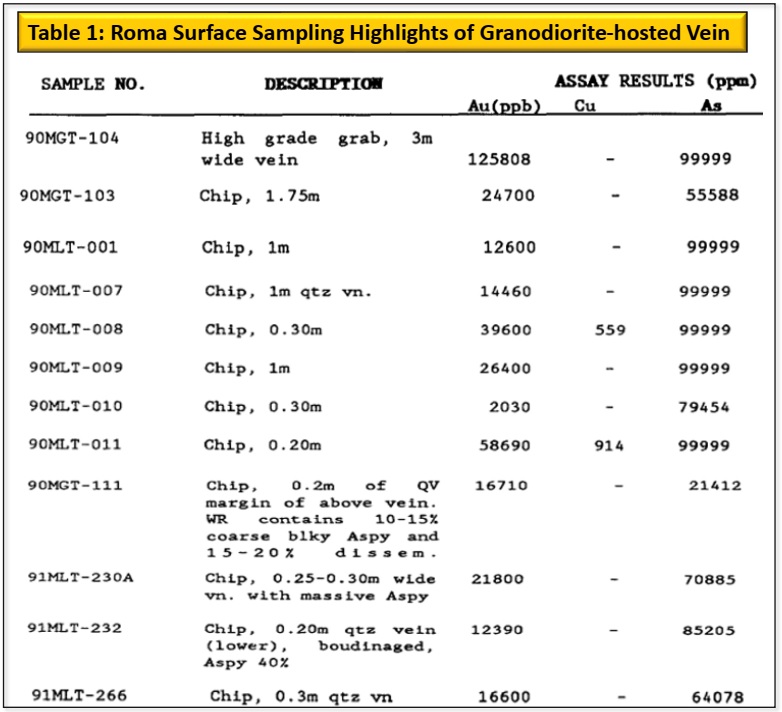
Table 1

Figure 4
About Blue Star Gold Corp.
Blue Star is a Vancouver-based gold and silver company focused on exploration and development within Nunavut, Canada. The Company owns the Ulu Gold Property lease, an advanced gold and silver project, and the highly prospective Hood River gold concessions that are contiguous with the Ulu mining lease. With the recent acquisition of the Roma Project, Blue Star now controls 16,645 hectares of highly prospective and underexplored mineral properties in the High Lake Greenstone Belt, Nunavut. A significant high-grade gold resource exists at the Flood Zone deposit (Ulu lease), and numerous high-grade gold occurrences and priority targets occur throughout the Ulu, Hood River and Roma Projects.
Blue Star is listed on the TSX Venture Exchange under the symbol: BAU and on the Frankfurt Exchange under the symbol: 5WP. For further information on the Company and its projects, please visit our website: www.bluestargold.ca.
For further information, please contact:
Grant Ewing, P. Geo., CEO
Blue Star Gold Corp.
Telephone: +1 778-379-1433
Email:
Neither the TSX Venture Exchange nor its Regulation Services Provider (as that term is defined in the Policies of the TSX-Venture Exchange) accepts responsibility for the adequacy or accuracy of this Release.
CAUTIONARY NOTE REGARDING FORWARD-LOOKING STATEMENTS AND INFORMATION
This press release contains “forward-looking statements” within the meaning of applicable securities laws. Forward-looking statements can be identified by words such as: “anticipate,” “intend,” “plan,” “goal,” “seek,” “believe,” “project,” “estimate,” “expect,” “strategy,” “future,” “likely,” “may,” “should,” “will” and similar references to future periods. Examples of forward-looking statements include, among others, statements we make regarding prospective income and revenues, anticipated levels of capital expenditures for fiscal year, expectations of the effect on our financial condition of claims, litigation, environmental costs, contingent liabilities and governmental and regulatory investigations and proceedings, and estimates of mineral resources and reserves on our properties.
Forward-looking statements are neither historical facts nor assurances of future performance. Instead, they are based only on our current beliefs, expectations and assumptions regarding the future of our business, future plans and strategies, projections, anticipated events and trends, the economy and other future conditions. Because forward-looking statements relate to the future, they are subject to inherent uncertainties, risks and changes in circumstances that are difficult to predict and many of which are outside of our control. Our actual results and financial condition may differ materially from those indicated in the forward-looking statements. Therefore, you should not rely on any of these forward-looking statements. Important factors that could cause our actual results and financial condition to differ materially from those indicated in the forward-looking statements include, among others, the following: economic and financial conditions, including volatility in interest and exchange rates, commodity and equity prices and the value of financial assets, strategic actions, including acquisitions and dispositions and our success in integrating acquired businesses into our operations, developments and changes in laws and regulations, including increased regulation of the mining industry through legislative action and revised rules and standards applied by the regulatory bodies in Nunavut, changes in the price of fuel and other key materials and disruptions in supply chains for these materials, closures or slowdowns and changes in labour costs and labour difficulties, including stoppages affecting either our operations or our suppliers’ abilities to deliver goods and services to us, as well as natural events such as severe weather, fires, floods and earthquakes or man-made or other disruptions of our equipment, and inaccuracies in estimates of mineral resources and/or reserves on our mineral properties.
